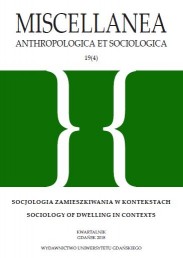Museum’s space and participation practices of exhibition visitors
DOI:
https://doi.org/10.26881/maes.2018.4.09Słowa kluczowe:
museum space, social space, aesthetic-fugal and aesthetic-petal space, museum audience, Julian Antoniszczak (Antonisz)Abstrakt
Museum space is generally considered as an environment completely neutral for art objects. However, such an amorphous treatment of space in a museum stands in a stark contrast with the results of the proxemic analyses, which point to the social dimension of every space. The aim of the article is to characterize the impact of museum space, perceived as social space, on the reception process of works of art. Based on the results of the public exhibition of Julian Antoniszczak works at MNK, the existence of exhibition space areas that facilitate the perception of art (aesthetic-petal) and having the opposite character (aesthetic-fugal) was pointed out. This identification of areas of the exhibition later became the basis for the typology of museum viewers. The established typology proves that those categories of viewers differ in way of perception of art, forms of behavior in a museum, as well as socio-demographic characteristics.
Downloads
Bibliografia
Appleton J., 1996, The experience of Landscape, London: Wiley-Blackwell.
Bańka A., 2016, Architektura psychologicznej przestrzeni życia. Behawioralne podstawy projektowania, Poznań: Stowarzyszenie Psychologia i Architektura.
Hall E.T., 1990, The hidden dimension, New York: Anchor Books Ed.
Hani J., 2006, Le Symbolisme du Temple Chrétien, Paris: Guy Trédaniel, Editions de la Maisnie.
Mariani-Rousset S., 2008, La méthode des parcours dans les lieux d’exposition [in:] M. Grosjean, J-P. Thibaud (eds.), L’espace urbain en méthodes, Marseille: Éditions Parenthéses, pp. 29–46.
McLuhan M., 1995, Understanding Media [in:] M. McLuhan, E. McLuhan, F. Zingrone (eds.), The Essential McLuhan, New York: Basic Books.
Melton A.W., 1935, Problems on installation in Museum of Art, American Association of Museums, no. 14.
Melton A.W., 1936, Distribution of Attention in Galeries in a Museum of Science and Industry, Museum News, vol. 14, no. 3.
Migliore I., Servetto M., 2007, Space Morphing. Migliore+Servetto temporary architecture, Mediolan: 5 Continents.
Pabich M., 2007, O kształtowaniu muzeum sztuki. Przestrzeń piękniejsza od przedmiotu, Katowice: Muzeum Śląskie.
Tröndle M., Wintzerith S., Wäspe R., Tschacher W., 2012, A museum for the twenty-first century: the influence of ‘sociality’ on art reception in museum space, Museum Management and Curatorship, no. 27(5), pp. 1–26.
Tschacher W., Greenwood S., Kirchberg V., Wintzerith S., van den Berg K., Tröndle M., 2012, Physiological correlates of aesthetic perception in a museum, Journal of Psychology of Aesthetics, Creativity, and the Arts, no. 6, pp. 96–103.
Tuan Y-F., 1977, Space and Place: The Perspective of Experience, Minneapolis: University of Minnesota Press.
Tzortzi K., 2015, Museum Space. Where Architecture Meets Museology, London–New York: Routledge.
Veron E., Lavasseur M., 1983, L’espace, le Corp, le sens: ethnographie d’une exposition: “Vacances en France”, Paris: Centre Georges Pompidou.

 Uniwersyteckie Czasopisma Naukowe
Uniwersyteckie Czasopisma Naukowe




